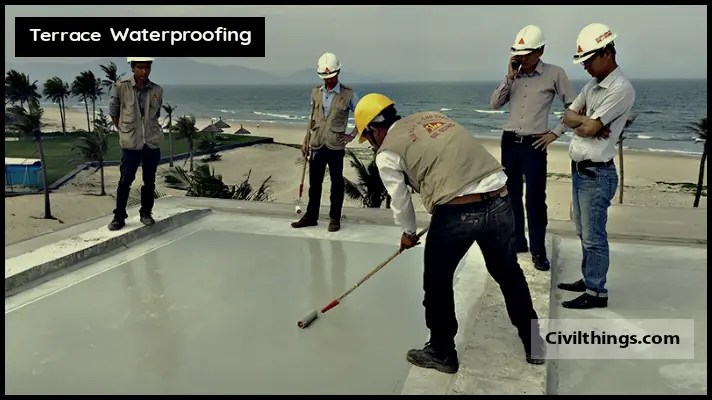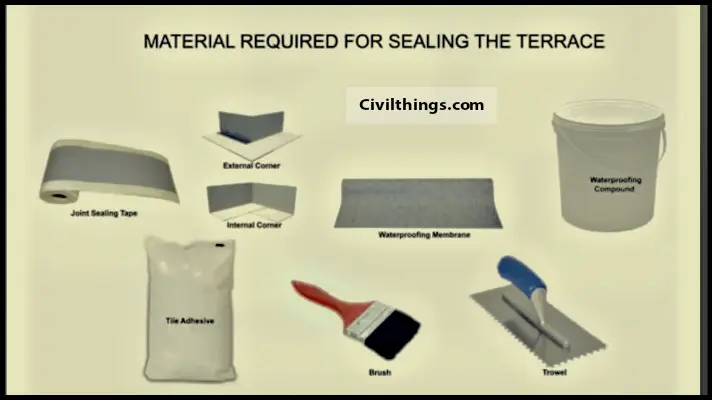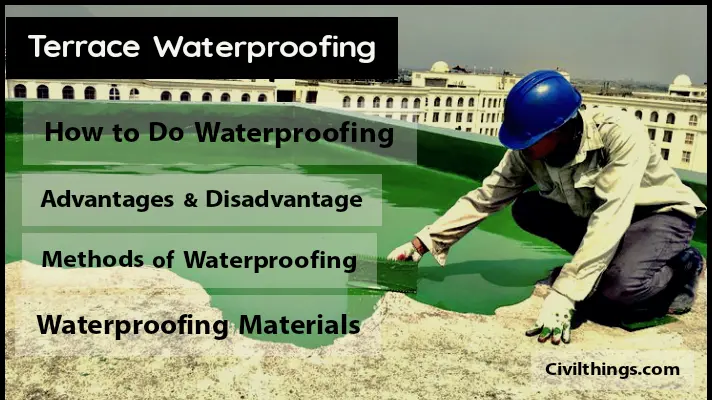Table of Contents
What is waterproofing?

If water is coming from the slab that is the roof of your house, moisture is coming into the house or the slab is leaking, then whatever preventive measures are taken on it is called waterproofing.
How to do waterproofing
Suppose, we want to waterproof the building which is our old building, then how much leakage is there in it, how much water is leaking and in how many areas, let’s first see if there is water leakage in a certain area, the rest of the slab is good, then the same waterproofing is good if there is a leak. It is never better to waterproof the whole slab if it is in more places.
Material required for sealing the terrace or roof

- Bituminous Waterproofing
- Polyurethane Liquid Membrane
- EPDM Membrane
- Torch Applied Membrane
- Cementitious Waterproofing
- Acrylic Waterproofing
- Liquid Applied Membrane
There are various types explanation of terrace or roofing waterproofing methods, including:
- Bituminous Waterproofing : Involves the use of bitumen or asphalt-based materials to create a waterproofing membrane.
- Polyurethane Liquid Membrane: Forms a seamless, durable, and flexible waterproofing layer when applied.
- EPDM Membrane: Ethylene Propylene Diene Monomer rubber is commonly used for flat roofs due to its durability and resistance to UV radiation.
- Torch Applied Membrane: Consists of modified bitumen sheets that are heat-welded to create a watertight seal.
- Cementitious Waterproofing: Uses a cement-based coating to create a waterproof barrier.
- Acrylic Waterproofing: Utilizes acrylic polymers to form a protective and flexible coating.
- Liquid Applied Membrane: A liquid coating that forms a continuous waterproofing layer when applied.
The choice depends on factors such as the type of roof, climate, budget, and specific requirements. Consulting with a professional can help determine the most suitable option for your particular situation.
The advantages of waterproofing for terraces include:
- Preventing Water Damage: Waterproofing creates a protective barrier, preventing water from seeping into the structure and causing damage.
- Increased Structural Longevity: It enhances the durability of the terrace, extending its lifespan by shielding it from moisture-related deterioration.
- Minimizing Maintenance Costs: Regular exposure to water can lead to costly repairs. Waterproofing reduces the need for frequent maintenance and repairs, saving money over time.
- Mold and Mildew Prevention: Waterproofing helps inhibit the growth of mold and mildew, promoting a healthier environment and preventing potential health issues.
- Preserving Aesthetic Appeal: It maintains the appearance of the terrace by preventing water stains, discoloration, and other aesthetic damages caused by moisture.
- Protecting Interior Spaces: Waterproofing safeguards the underlying structures, preventing water from reaching interior spaces and causing damage to ceilings, walls, and belongings.
- Enhancing Property Value: A well-maintained, waterproofed terrace contributes to the overall value of the property, making it more attractive to potential buyers or tenants.
The Disadvantages of waterproofing for terraces include:
- Cost:Waterproofing can be initially expensive, especially if extensive repairs or professional services are required.
- Application Challenges: Improper application of waterproofing materials may lead to inefficiencies or even failure, requiring reapplication and additional costs.
- Disruption during Installation: The process of applying waterproofing materials may cause inconvenience and disruption to regular activities, particularly if the terrace is in use during the application.
- Limited Lifespan: Waterproofing systems have a finite lifespan, and periodic maintenance or reapplication may be necessary to ensure continued effectiveness
- Selection Challenges: Choosing the right waterproofing materials and methods for a specific type of terrace can be challenging, and selecting the wrong ones may result in suboptimal performance.
- Environmental Impact: Some waterproofing materials may have environmental concerns or ecological impact, so it’s important to consider eco-friendly options.
- Potential for Trapped Moisture: Improper installation or inadequate ventilation could lead to the trapping of moisture, causing issues like condensation or mold growth.
Process of Terrace Waterproofing
Important Links
2. Why AAC Blocks are a Smart Choice for Construction
FAQ
How to do waterproofing
Suppose, we want to waterproof the building which is our old building, then how much leakage is there in it, how much water is leaking and in how many areas, let’s first see if there is water leakage in a certain area, the rest of the slab is good, then the same waterproofing is good if there is a leak. It is never better to waterproof the whole slab if it is in more places.
How to do waterproofing of terrace in India
Surface Prep:Clean terrace thoroughly.Repair any cracks with a crack-filling compound.
Drainage:Ensure proper slope for water drainage.
Apply Primer:Use a waterproofing primer for better adhesion.
Waterproofing:Apply chosen material (liquid membrane, roll-on, or cementitious coating).Reinforce with fabric for liquid membranes.
Curing:Allow for complete curing following manufacturer’s instructions.
Check for Leaks:Perform a water test to identify and fix leaks.
Final Protection (Optional):Add tiles or a cement-sand plaster for extra protection.
Maintenance:Regularly check for damages and perform repairs as needed.

Hello! I’m Vaishnavi, a civil engineer who enjoys sharing how we design and build structures. My blog makes understanding engineering easy and interesting for everyone!


it is really Helpful information of terrace Waterproofing